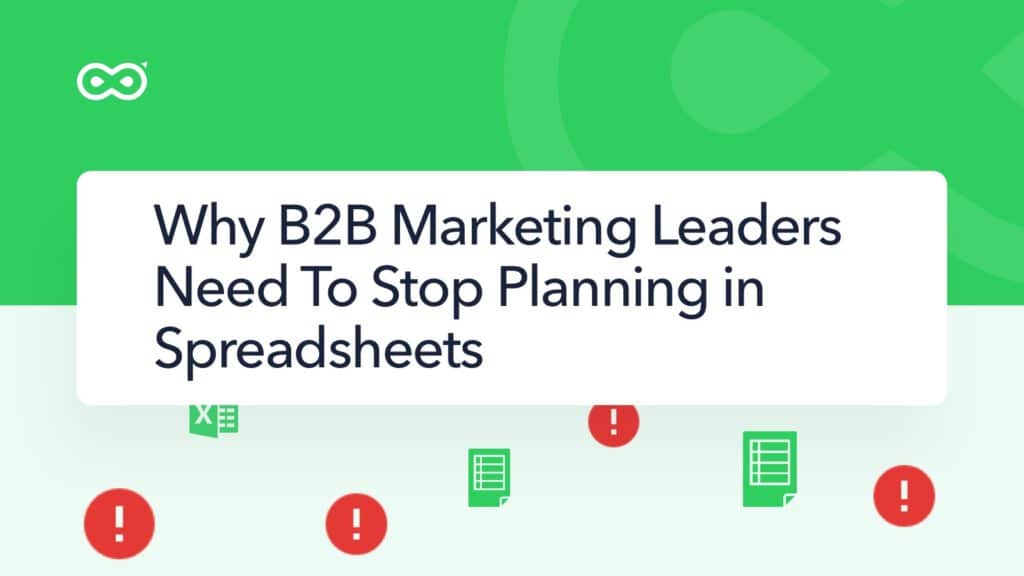Spreadsheets have become the format of choice for B2B marketers when it comes to marketing planning and budgeting.
Ever since the release of Microsoft Excel in 1982, marketing leaders have been using it to plan their marketing budgets and allocations, review results, analyze data and model/forecast their future results.
But there’s a problem…
Despite originally being called Multiplan (Good one Microsoft ????), Excel was not built, nor was it ever adapted to the specifics of marketing planning, especially in the fast-paced, data-filled, revenue-oriented world of B2B marketing that we have today.
The sheer amount of data that revenue marketers are collecting and analyzing have made spreadsheets an inefficient way to plan marketing. From understanding which channels and activities contribute to revenue goals, to calculating return on marketing investment (ROMI) and forecasting a marketing budget’s business outcomes, Excel is just not suited for a revenue-driven B2B marketing world.
B2B marketers who continue to use spreadsheets to plan and track their marketing are putting themselves at a disadvantage compared to the modern marketing leaders, who are taking advantage of modern technology and AI capabilities to make sense of their data and know what to do and where to invest to hit their goals and KPIs.
While there are many reasons why B2B marketing leaders should break their addiction to marketing planning in spreadsheets, here are the top 3 that should make you quit today.

Spreadsheets aren’t connected (to your live data)
If we had to pick one reason why marketing leaders need to stop using spreadsheets for marketing planning right now, THIS IS IT!
With so much data coming from so many different sources, it’s not possible to connect everything to a single, convenient spreadsheet. It even sounds weird having the word “convenient” and “spreadsheet” in the same sentence!
Theoretically, you could try to use some crazy APIs to pull some of the data into your spreadsheets, but it would take a lot of time and it would require the help of someone who knows what the hell they are doing. Even worse, you’re not going to get all of the information that you need.
And that’s pretty dangerous! ????
You want to have all your live data, when and where you are making your decisions!
Not having all available (and crucial) data at your disposal means that you aren’t getting the whole picture. And if you’re not getting the whole picture, you aren’t making informed decisions about your marketing.

Spreadsheets are totally disorganized!
Marketing spreadsheets are chaotic!
There, I said it.
Modern B2B marketing organizations use, on average, between 40 to 200 tools in their marketing technology stack, depending on the size of the company.
Taking all that data from those platforms and integrating it into a single spreadsheet isn’t an option.
This has resulted in marketing planning and analysis being done across multiple spreadsheets (don’t even get me started on all the tabs and color-coding!). You almost need an instruction manual to understand what you’re looking at and what’s going on within those spreadsheets.
Eleven better is how you have to use formulas and vlookups to connect data and multiple spreadsheets. One little screw up in a single cell can mess up everything! And good luck going back and trying to find where the error came from (see you next year!).
If all this isn’t enough, you have the problem of scale. As your organization grows, it becomes a lot more difficult to update, manage and organize all your spreadsheets for planning and data exports. It’s no wonder that Digital Asset Management (DAM) has become a $3.4B industry!

Spreadsheets create a “set and forget” mentality towards marketing planning
Taking a “set and forget” mentality when it comes to marketing planning is a great way to underperform and miss your KPIs.
For most B2B marketing leaders, the marketing planning season (there shouldn’t be one, but we’ll discuss that in a future post) generally happens in October/November when they collect and analyze their data, draw insights from their past performance and build out their plans and budgets for the coming year.
Working with so many disorganized and disconnected spreadsheets has caused marketing leaders to view marketing planning as a pain…something that needs to be done but not something particularly enjoyable.
Essentially, they are creating their plans and budgets during the planning season and returning at the end of each quarter (maybe?) to review progress and make some changes (maybe?).
The B2B marketers that constantly keep an eye on their plans, know where they stand on achieving their goals and are ready to act by dynamically reallocating budgets to ensure they hit their goals on a regular basis are better positioned to achieve success than ones who don’t. Agility wins. If you are stationary in your planning and budgeting, you will never be able to achieve the best results possible for your marketing organization.

Summing It Up
Just like in the 1980’s, too many B2B marketing leaders are still using spreadsheets to analyze their data, plan their marketing, forecast results and allocate their budgets.
But the amount of data that modern marketers are collecting and working with has totally changed the game. And let’s face it, tools from the 1980s aren’t going to cut it.
Planning your marketing and understanding where to invest your marketing budget to generate the best results possible is a fundamental responsibility of a B2B marketing leader.
To build a successful marketing organization, you need to simplifying the marketing planning process and taking a data-driven approach to budget decision making.
…and you’re not going to be able to do this in spreadsheets.



